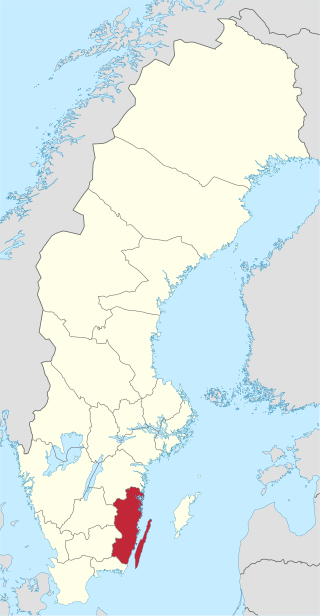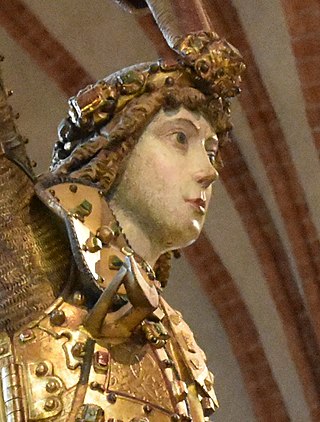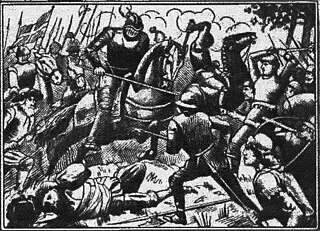
Kalmar County is a county or län in southern Sweden. It borders the counties of Kronoberg, Jönköping, Blekinge and Östergötland. To the east in the Baltic Sea is the island Gotland.

Sten Sture the Elder was a Swedish statesman and regent of Sweden from 1470 to 1497 and again from 1501 to 1503. As the leader of the victorious Swedish separatist forces against the royal unionist forces during the Battle of Brunkeberg in 1471, he weakened the Kalmar Union considerably and became the effective ruler of Sweden as Lord Regent for most of his remaining life.

Kettil Karlsson (Vasa) (c. 1433 – 11 August 1465) was a Swedish clergyman, diplomat, military leader and statesman during the Kalmar Union era. He was a member of the house of Vasa. At age 25, he was elected Bishop of Linköping. He rebelled against King Christian I in 1463, was Captain General (rikshövitsman) and de facto regent of Sweden from February to August 1464, stepping down during the brief return of King Charles Canutesson from exile. After falling out with King Charles, Kettil Karlsson was subsequently elected Lord Protector and Regent (riksföreståndare) of Sweden from 26 December 1464 to his death.

Erik Axelsson (Tott) (c. 1419–1481) was a Dano-Swedish statesman who served as the regent of Sweden under the Kalmar Union, jointly with Jöns Bengtsson Oxenstierna in 1457 and alone from 1466 to 1467.

Karl Knutsson Bonde, also known as Charles VIII and called Charles I in Norwegian contexts, was King of Sweden and King of Norway (1449–1450).

Søren Norby, selfstyled as Severin Norbi was a Danish leading naval officer in the fleets of Danish kings Hans I and Christian II. He commandeered the greatest ship of the Danish fleet in naval wars against Sweden and Lübeck. Norby governed various land possessions in Scandinavia, ruling Gotland from 1517 to 1525. His rebellion against Frederick I of Denmark in 1525 was defeated, and he fled Denmark, ending his life in the employ of Charles V, Holy Roman Emperor.
Eric Bielke, also known as Eerikki Tuurenpoika and Eric Tureson, royal councillor of Sweden, knighted, feudal fiefholder or margrave of Vyborg Castle.

Vyborg Castle is a fortress in Vyborg, Russia. It was built by the Swedes during the Middle Ages around which the town of Vyborg evolved. The castle became the stronghold of the Swedish realm in the Karelian region. Throughout the centuries, it was the first defense of the kingdom against the Russians. Its military and strategic status in the late Middle Ages was second only to the fortified capital Stockholm. Currently it serves as the site of Vyborg Regional Museum.
The Fief of Viborg (1320–1534) was for two centuries a late medieval fief in the southeastern border of Finland and the entire Swedish realm. It was held by its chatelain, a fief-appointed feudal lord.
Arvid Birgersson, Lord of Bergkvara was a Swedish magnate and politician in the last decades of Middle Ages. He was justiciar of Östergötland and then of Tiohärad, as well as a Lord High Councillor of Sweden, and once a candidate for Regent. His family coat of arms depict a headless troll whereby some have retrospectively called him Arvid Trolle.

Ingeborg Åkesdotter Tott, in her lifetime called Ingeborg Åkesdotter or simply Fru Ingeborg, was a Swedish noble, the consort of the Swedish regent Sten Sture the Elder. She was the fiefholder of Häme in Finland. She functioned as the de facto queen consort of Sweden for over three decades and participated in state affairs during the reign of her spouse.
Brita Olovsdotter Tott or Birgitte Olufsdatter Thott, was a Danish and Swedish noble, landowner and royal county administrator She was judged for treason and for the forgery of seals. She was one of the biggest landowners in Scandinavia, and her estates played a role in politics in Sweden and Denmark.

Magdalena of Sweden was a Swedish princess. She was the daughter of Charles VIII of Sweden and his first queen consort, Catherine Karlsdotter. In 1468–1470, her spouse Ivar Axelsson (Tott) was the promised successor of her father as regent.

Stegeborg Castle is a ruined castle in St Anna parish, Söderköping, Östergötland, located on an island in a narrow sound at the bay of Slätbaken.

Katarina Erikintytär Nipertz was a Swedish noblewoman and fiefholder of Raseborg Castle, Sweden.

The Dano-Swedish War from 1501 to 1512 was a military conflict between Denmark and Sweden within the Kalmar Union.
The War in Gotland (1448–1449) was an invasion of the island of Gotland by King Karl Knutsson in 1448.

The Dano-Swedish War (1512–1520), is the name of the conflict that lasted 1512–1520 and was part of the Union Wars at the time of the Kalmar Union. The war was between the opponents of the union and the Danish king Hans, later his son Christian II, and ended in 1520 after Sten Sture the Younger died as a result of injuries at Battle of Bogesund and Christian II marched into Stockholm in September of the same year.

Tott's Russian wars refers to a series of two wars waged by Erik Axelsson Tott against Russia. The first one occurred from 1475–1476, with the other one going from 1479–1482.















